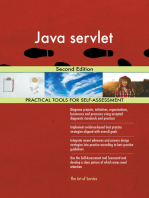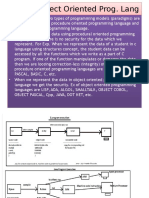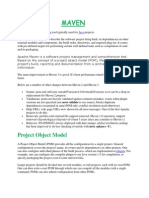Tutorials Point, Simply Easy Learning: Java Tutorial
Uploaded by
Ali Elsayed SalemTutorials Point, Simply Easy Learning: Java Tutorial
Uploaded by
Ali Elsayed SalemTutorials Point, Simply Easy Learning
Java Tutorial Tutorialspoint.com
Java is a high-level programming language originally developed by Sun Microsystems and released in 1995. Java runs on a variety of platforms, such as Windows, Mac OS, and the various versions of UNIX. This tutorial gives an initial push to start you with Java. For more detail kindly check tutorialspoint.com/java
What is Java?
Java is:
Object Oriented Platform independent: Simple Secure Architectural- neutral Portable Robust Multi-threaded Interpreted High Performance Distributed Dynamic
Java Environment Setup:
Java SE is freely available from the link Download Java. So you download a version based on your operating system. You can refere to installation guide for a complete detail.
Java Basic Syntax:
Object - Objects have states and behaviors. Example: A dog has states-color, name, breed as well as behaviors -wagging, barking, eating. An object is an instance of a class. Class - A class can be defined as a template/ blue print that describe the behaviors/states that object of its type support. Methods - A method is basically a behavior. A class can contain many methods. It is in methods where the logics are written, data is manipulated and all the actions are executed. Instant Variables - Each object has its unique set of instant variables. An object.s state is created by the values assigned to these instant variables.
First Java Program:
Let us look at a simple code that would print the words Hello World.
public class MyFirstJavaProgram{
1|Page
Tutorials Point, Simply Easy Learning
/* This is my first java program. * This will print 'Hello World' as the output */ public static void main(String []args){ System.out.println("Hello World"); // prints Hello World } }
About Java programs, it is very important to keep in mind the following points.
Case Sensitivity - Java is case sensitive which means identifier Hello and hello would have different meaning in Java. Class Names - For all class names the first letter should be in Upper Case. If several words are used to form a name of the class each inner words first letter should be in Upper Case.
Example class MyFirstJavaClass Method Names - All method names should start with a Lower Case letter. If several words are used to form the name of the method, then each inner word's first letter should be in Upper Case.
Example public void myMethodName() Program File Name - Name of the program file should exactly match the class name. When saving the file you should save it using the class name (Remember java is case sensitive) and append '.java' to the end of the name. (if the file name and the class name do not match your program will not compile). Example : Assume 'MyFirstJavaProgram' is the class name. Then the file should be saved as 'MyFirstJavaProgram.java' public static void main(String args[]) - java program processing starts from the main() method which is a mandatory part of every java program..
Java Identifiers:
All java components require names. Names used for classes, variables and methods are called identifiers. In java there are several points to remember about identifiers. They are as follows:
All identifiers should begin with a letter (A to Z or a to z ), currency character ($) or an underscore (-). After the first character identifiers can have any combination of characters. A key word cannot be used as an identifier. Most importantly identifiers are case sensitive. Examples of legal identifiers:age, $salary, _value, __1_value Examples of illegal identifiers : 123abc, -salary
Java Modifiers:
Like other languages it is possible to modify classes, methods etc by using modifiers. There are two categories of modifiers.
Access Modifiers : defualt, public , protected, private
2|Page
Tutorials Point, Simply Easy Learning
Non-access Modifiers : final, abstract, strictfp
We will be looking into more details about modifiers in the next section.
Java Variables:
We would see following type of variables in Java:
Local Variables Class Variables (Static Variables) Instance Variables (Non static variables)
Java Arrays:
Arrays are objects that store multiple variables of the same type. However an Array itself is an object on the heap. We will look into how to declare, construct and initialize in the upcoming chapters.
Java Enums:
Enums were introduced in java 5.0. Enums restrict a variable to have one of only a few predefined values. The values in this enumerated list are called enums. With the use of enums it is possible to reduce the number of bugs in your code. For example if we consider an application for a fresh juice shop it would be possible to restrict the glass size to small, medium and Large. This would make sure that it would not allow anyone to order any size other than the small, medium or large.
Example:
class FreshJuice{ enum FreshJuiceSize{ SIZE, MEDUIM, LARGE } FreshJuiceSize size; } public class FreshJuiceTest{ public static void main(String args[]){ FreshJuice juice = new FreshJuice(); juice.size = FreshJuice. FreshJuiceSize.MEDUIM ; } }
Note: enums can be declared as their own or inside a class. Methods, variables, constructors can be defined inside enums as well.
Java Keywords:
The following list shows the reserved words in Java. These reserved words may not be used as constant or variable or any other identifier names. abstract assert boolean break
3|Page
Tutorials Point, Simply Easy Learning
byte class do extends for import long private short switch throws volatile case const double final goto instanceof native protected static synchronized transient while catch continue else finally if int new public strictfp this try char default enum float implements interface package return super throw void
Comments in Java
Java supports single line and multi-line comments very similar to c and c++. All characters available inside any comment are ignored by Java compiler.
public class MyFirstJavaProgram{ /* This is my first java program. * This will print 'Hello World' as the output * This is an example of multi-line comments. */ public static void main(String []args){ // This is an example of single line comment /* This is also an example of single line comment. */ System.out.println("Hello World"); } }
Data Types in Java
There are two data types available in Java: 1. Primitive Data Types
4|Page
Tutorials Point, Simply Easy Learning
2. Reference/Object Data Types
Primitive Data Types:
There are eight primitive data types supported by Java. Primitive data types are predefined by the language and named by a key word. Let us now look into detail about the eight primitive data types.
byte short int long float double boolean char
Reference Data Types:
Reference variables are created using defined constructors of the classes. They are used to access objects. These variables are declared to be of a specific type that cannot be changed. For example, Employee, Puppy etc. Class objects, and various type of array variables come under reference data type. Default value of any reference variable is null. A reference variable can be used to refer to any object of the declared type or any compatible type. Example : Animal animal = new Animal("giraffe");
Java Literals:
A literal is a source code representation of a fixed value. They are represented directly in the code without any computation. Literals can be assigned to any primitive type variable. For example:
byte a = 68; char a = 'A'
String literals in Java are specified like they are in most other languages by enclosing a sequence of characters between a pair of double quotes. Examples of string literals are:
"Hello World" "two\nlines" "\"This is in quotes\""
Java language supports few special escape sequences for String and char literals as well. They are: Notation \n Newline (0x0a) Character represented
5|Page
Tutorials Point, Simply Easy Learning
\r \f \b \s \t \" \' \\ \ddd \uxxxx Carriage return (0x0d) Formfeed (0x0c) Backspace (0x08) Space (0x20) tab Double quote Single quote backslash Octal character (ddd) Hexadecimal UNICODE character (xxxx)
Java Access Modifiers:
Java provides a number of access modifiers to set access levels for classes, variables, methods and constructors. The four access levels are: 1. 2. 3. 4. Visible Visible Visible Visible to to to to the the the the package. the default. No modifiers are needed. class only (private). world (public). package and all subclasses (protected).
Java Basic Operators:
Java provides a rich set of operators to manipulate variables. We can divide all the Java operators into the following groups:
The Arithmetic Operators:
Operator + Description Addition - Adds values on either side of the operator Subtraction - Subtracts right hand operand from left hand operand Example A + B will give 30
A - B will give -10
Multiplication - Multiplies values on either A * B will give 200 side of the operator
6|Page
Tutorials Point, Simply Easy Learning
/ Division - Divides left hand operand by right hand operand Modulus - Divides left hand operand by right hand operand and returns remainder Increment - Increase the value of operand by 1 Decrement - Decrease the value of operand by 1 B / A will give 2
B % A will give 0
++
B++ gives 21
--
B-- gives 19
The Relational Operators:
Operator == Description Checks if the value of two operands are equal or not, if yes then condition becomes true. Checks if the value of two operands are equal or not, if values are not equal then condition becomes true. Checks if the value of left operand is greater than the value of right operand, if yes then condition becomes true. Checks if the value of left operand is less than the value of right operand, if yes then condition becomes true. Checks if the value of left operand is greater than or equal to the value of right operand, if yes then condition becomes true. Checks if the value of left operand is less than or equal to the value of right operand, if yes then condition becomes true. Example (A == B) is not true.
!=
(A != B) is true.
>
(A > B) is not true.
<
(A < B) is true.
>=
(A >= B) is not true.
<=
(A <= B) is true.
The Bitwise Operators:
Operator Description Example
7|Page
Tutorials Point, Simply Easy Learning
& Binary AND Operator copies a bit to the result if it exists in both operands. Binary OR Operator copies a bit if it exists in eather operand. Binary XOR Operator copies the bit if it is set in one operand but not both. Binary Ones Complement Operator is unary and has the efect of 'flipping' bits. Binary Left Shift Operator. The left operands value is moved left by the number of bits specified by the right operand. Binary Right Shift Operator. The left operands value is moved right by the number of bits specified by the right operand. Shift right zero fill operator. The left operands value is moved right by the number of bits specified by the right operand and shifted values are filled up with zeros. (A & B) will give 12 which is 0000 1100
(A | B) will give 61 which is 0011 1101
(A ^ B) will give 49 which is 0011 0001
(~A ) will give -60 which is 1100 0011
<<
A << 2 will give 240 which is 1111 0000
>>
A >> 2 will give 15 which is 1111
>>>
A >>>2 will give 15 which is 0000 1111
The Logical Operators:
Operator && Description Called Logical AND operator. If both the operands are non zero then then condition becomes true. Called Logical OR Operator. If any of the two operands are non zero then then condition becomes true. Called Logical NOT Operator. Use to reverses the logical state of its operand. If a condition is true then Logical NOT operator will make false. Example (A && B) is false.
||
(A || B) is true.
!(A && B) is true.
The Assignment Operators:
Operator Description Example
8|Page
Tutorials Point, Simply Easy Learning
= Simple assignment operator, Assigns values from right side operands to left side operand Add AND assignment operator, It adds right operand to the left operand and assign the result to left operand Subtract AND assignment operator, It subtracts right operand from the left operand and assign the result to left operand Multiply AND assignment operator, It multiplies right operand with the left operand and assign the result to left operand Divide AND assignment operator, It divides left operand with the right operand and assign the result to left operand Modulus AND assignment operator, It takes modulus using two operands and assign the result to left operand Left shift AND assignment operator C = A + B will assigne value of A + B into C
+=
C += A is equivalent to C = C + A
-=
C -= A is equivalent to C = C - A
*=
C *= A is equivalent to C = C * A
/=
C /= A is equivalent to C = C / A
%=
C %= A is equivalent to C = C % A
<<= >>= &= ^=
C <<= 2 is same as C = C << 2
Right shift AND assignment operator C >>= 2 is same as C = C >> 2 Bitwise AND assignment operator bitwise exclusive OR and assignment operator bitwise inclusive OR and assignment operator C &= 2 is same as C = C & 2 C ^= 2 is same as C = C ^ 2
|=
C |= 2 is same as C = C | 2
Misc Operators
There are few other operators supported by Java Language.
Conditional Operator ( ? : ):
9|Page
Tutorials Point, Simply Easy Learning
Conditional operator is also known as the ternary operator. This operator consists of three operands and is used to evaluate boolean expressions. The goal of the operator is to decide which value should be assigned to the variable. The operator is written as :
variable x = (expression) ? value if true : value if false
instanceOf Operator:
This operator is used only for object reference variables. The operator checks whether the object is of a particular type(class type or interface type). instanceOf operator is wriiten as:
( Object reference variable ) instanceOf
(class/interface type)
Precedence of Java Operators:
Category Postfix Unary Multiplicative Additive Shift Relational Equality Bitwise AND Bitwise XOR Bitwise OR Logical AND Logical OR Conditional Assignment Comma () [] . (dot operator) ++ - - ! ~ */% +>> >>> << > >= < <= == != & ^ | && || ?: = += -= *= /= %= >>= <<= &= ^= |= , Operator Associativity Left to right Right to left Left to right Left to right Left to right Left to right Left to right Left to right Left to right Left to right Left to right Left to right Right to left Right to left Left to right
10 | P a g e
Tutorials Point, Simply Easy Learning
The while Loop:
A while loop is a control structure that allows you to repeat a task a certain number of times.
Syntax:
The syntax of a while loop is:
while(Boolean_expression) { //Statements }
The do...while Loop:
A do...while loop is similar to a while loop, except that a do...while loop is guaranteed to execute at least one time.
Syntax:
The syntax of a do...while loop is:
do { //Statements }while(Boolean_expression);
The for Loop:
A for loop is a repetition control structure that allows you to efficiently write a loop that needs to execute a specific number of times. A for loop is useful when you know how many times a task is to be repeated.
Syntax:
The syntax of a for loop is:
for(initialization; Boolean_expression; update) { //Statements }
Enhanced for loop in Java:
As of java 5 the enhanced for loop was introduced. This is mainly used for Arrays.
Syntax:
The syntax of enhanced for loop is:
11 | P a g e
Tutorials Point, Simply Easy Learning
for(declaration : expression) { //Statements }
The break Keyword:
The break keyword is used to stop the entire loop. The break keyword must be used inside any loop or a switch statement. The break keyword will stop the execution of the innermost loop and start executing the next line of code after the block.
The continue Keyword:
The continue keyword can be used in any of the loop control structures. It causes the loop to immediately jump to the next iteration of the loop.
In a for loop, the continue keyword causes flow of control to immediately jump to the update statement. In a while loop or do/while loop, flow of control immediately jumps to the Boolean expression.
Syntax:
The syntax of a continue is a single statement inside any loop:
continue;
The if Statement:
An if statement consists of a Boolean expression followed by one or more statements.
Syntax:
The syntax of an if statement is:
if(Boolean_expression) { //Statements will execute if the Boolean expression is true }
The if...else Statement:
An if statement can be followed by an optional else statement, which executes when the Boolean expression is false.
Syntax:
The syntax of a if...else is:
12 | P a g e
Tutorials Point, Simply Easy Learning
if(Boolean_expression){ //Executes when the Boolean expression is true }else{ //Executes when the Boolean expression is false }
The if...else if...else Statement:
An if statement can be followed by an optional else if...else statement, which is very usefull to test various conditions using single if...else if statement.
Syntax:
The syntax of a if...else is:
if(Boolean_expression 1){ //Executes when the Boolean expression 1 is true }else if(Boolean_expression 2){ //Executes when the Boolean expression 2 is true }else if(Boolean_expression 3){ //Executes when the Boolean expression 3 is true }else { //Executes when the one of the above condition is true. }
Nested if...else Statement:
It is always legal to nest if-else statements. When using if , else if , else statements there are few points to keep in mind.
An if can have zero or one else's and it must come after any else if's. An if can have zero to many else if's and they must come before the else. Once an else if succeeds, none of he remaining else if's or else's will be tested.
Syntax:
The syntax for a nested if...else is as follows:
if(Boolean_expression 1){ //Executes when the Boolean expression 1 is true if(Boolean_expression 2){ //Executes when the Boolean expression 2 is true } }
The switch Statement:
A switch statement allows a variable to be tested for equality against a list of values. Each value is called a case, and the variable being switched on is checked for each case.
Syntax:
The syntax of enhanced for loop is:
13 | P a g e
Tutorials Point, Simply Easy Learning
switch(expression){ case value : //Statements break; //optional case value : //Statements break; //optional //You can have any number of case statements. default : //Optional //Statements }
Java Methods:
A Java method is a collection of statements that are grouped together to perform an operation. When you call the System.out.println method, for example, the system actually executes several statements in order to display a message on the console. In general, a method has the following syntax:
modifier returnValueType methodName(list of parameters) { // Method body; }
A method definition consists of a method header and a method body. Here are all the parts of a method:
Modifiers: The modifier, which is optional, tells the compiler how to call the method. This defines the access type of the method. Return Type: A method may return a value. The returnValueType is the data type of the value the method returns. Some methods perform the desired operations without returning a value. In this case, the returnValueType is the keyword void. Method Name: This is the actual name of the method. The method name and the parameter list together constitute the method signature. Parameters: A parameter is like a placeholder. When a method is invoked, you pass a value to the parameter. This value is referred to as actual parameter or argument. The parameter list refers to the type, order, and number of the parameters of a method. Parameters are optional; that is, a method may contain no parameters. Method Body: The method body contains a collection of statements that define what the method does.
Java Classes & Objects:
Object - Objects have states and behaviors. Example: A dog has states-color, name, breed as well as behaviors -wagging, barking, eating. An object is an instance of a class. Class - A class can be defined as a template/ blue print that describe the behaviors/states that object of its type support.
A sample of a class is given below:
public class Dog{ String breed; int age; String color;
14 | P a g e
Tutorials Point, Simply Easy Learning
void barking(){ } void hungry(){ } void sleeping(){ } }
A class can contain any of the following variable types.
Local variables . variables defined inside methods, constructors or blocks are called local variables. The variable will be declared and initialized within the method and the variable will be destroyed when the method has completed. Instance variables . Instance variables are variables within a class but outside any method. These variables are instantiated when the class is loaded. Instance variables can be accessed from inside any method, constructor or blocks of that particular class. Class variables . Class variables are variables declared with in a class, outside any method, with the static keyword.
Exceptions Handling:
A method catches an exception using a combination of the try and catch keywords. A try/catch block is placed around the code that might generate an exception. Code within a try/catch block is referred to as protected code, and the syntax for using try/catch looks like the following:
try { //Protected code }catch(ExceptionName e1) { //Catch block }
Multiple catch Blocks:
A try block can be followed by multiple catch blocks. The syntax for multiple catch blocks looks like the following:
try { //Protected code }catch(ExceptionType1 e1) { //Catch block }catch(ExceptionType2 e2) { //Catch block }catch(ExceptionType3 e3) { //Catch block }
The throws/throw Keywords:
15 | P a g e
Tutorials Point, Simply Easy Learning
If a method does not handle a checked exception, the method must declare it using the throws keyword. The throws keyword appears at the end of a method's signature. You can throw an exception, either a newly instantiated one or an exception that you just caught, by using the throw keyword. Try to understand the different in throws and throw keywords.
The finally Keyword
The finally keyword is used to create a block of code that follows a try block. A finally block of code always executes, whether or not an exception has occurred. Using a finally block allows you to run any cleanup-type statements that you want to execute, no matter what happens in the protected code. A finally block appears at the end of the catch blocks and has the following syntax:
try { //Protected code }catch(ExceptionType1 e1) { //Catch block }catch(ExceptionType2 e2) { //Catch block }catch(ExceptionType3 e3) { //Catch block }finally { //The finally block always executes. }
Further Detail: Refer to the link http://www.tutorialspoint.com/java
List of Tutorials from TutorialsPoint.com
Learn JSP Learn Servlets Learn log4j Learn iBATIS Learn Java Learn JDBC Java Examples Learn Best Practices Learn Python Learn Ruby Learn Ruby on Rails
Learn ASP.Net Learn HTML Learn HTML5 Learn XHTML Learn CSS Learn HTTP Learn JavaScript Learn jQuery Learn Prototype Learn script.aculo.us Web Developer's Guide
16 | P a g e
Tutorials Point, Simply Easy Learning
Learn SQL Learn MySQL Learn AJAX Learn C Programming Learn C++ Programming Learn CGI with PERL Learn DLL Learn ebXML Learn Euphoria Learn GDB Debugger Learn Makefile Learn Parrot Learn Perl Script Learn PHP Script Learn Six Sigma Learn SEI CMMI Learn WiMAX Learn Telecom Billing
Learn RADIUS Learn RSS Learn SEO Techniques Learn SOAP Learn UDDI Learn Unix Sockets Learn Web Services Learn XML-RPC Learn UML Learn UNIX Learn WSDL Learn i-Mode Learn GPRS Learn GSM Learn WAP Learn WML Learn Wi-Fi
webmaster@TutorialsPoint.com
17 | P a g e
You might also like
- Java Algorithms for Beginners: A Practical Guide with ExamplesFrom EverandJava Algorithms for Beginners: A Practical Guide with ExamplesNo ratings yet
- Object Oriented Programming Methodology (CS and IT)No ratings yetObject Oriented Programming Methodology (CS and IT)2 pages
- Continuous Integration (Jenkins/Hudson)No ratings yetContinuous Integration (Jenkins/Hudson)41 pages
- Object Oriented Programming Through JavaNo ratings yetObject Oriented Programming Through Java16 pages
- Case Study Based On: Cloud Deployment and Service Delivery ModelsNo ratings yetCase Study Based On: Cloud Deployment and Service Delivery Models10 pages
- Java Is Object Oriented Prog. Lang Java Is Object Oriented Prog. LangNo ratings yetJava Is Object Oriented Prog. Lang Java Is Object Oriented Prog. Lang37 pages
- Data Structure and Algorithms in Java: From Basics to Expert ProficiencyFrom EverandData Structure and Algorithms in Java: From Basics to Expert ProficiencyNo ratings yet
- Mastering Java Persistence: From Basics to Expert ProficiencyFrom EverandMastering Java Persistence: From Basics to Expert ProficiencyNo ratings yet
- Introduction To Java Programming - TutorialNo ratings yetIntroduction To Java Programming - Tutorial50 pages
- How To Print Pyramid Pattern in Java - Program Example - Java67No ratings yetHow To Print Pyramid Pattern in Java - Program Example - Java6724 pages
- Linux System Programming Part 3 - Filesystem and Files: IBA Bulgaria 2018No ratings yetLinux System Programming Part 3 - Filesystem and Files: IBA Bulgaria 201817 pages
- Mastering the Art of Node.js Programming: Unraveling the Secrets of Expert-Level ProgrammingFrom EverandMastering the Art of Node.js Programming: Unraveling the Secrets of Expert-Level ProgrammingNo ratings yet
- Eclipse Java Tutorial: 1. Download and Install JavaNo ratings yetEclipse Java Tutorial: 1. Download and Install Java4 pages



























































